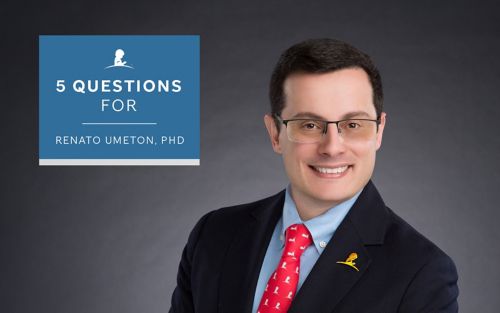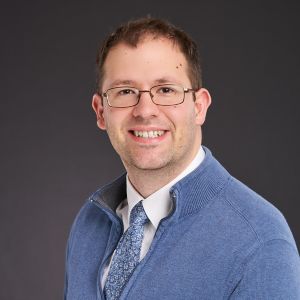St. Jude Family of Websites
Explore our cutting edge research, world-class patient care, career opportunities and more.
St. Jude Children's Research Hospital Home

- Fundraising
St. Jude Family of Websites
Explore our cutting edge research, world-class patient care, career opportunities and more.
St. Jude Children's Research Hospital Home

- Fundraising
5 Questions for Renato Umeton, PhD

Renato Umeton, PhD, is the first Chief of Artificial Intelligence within the Office of Data Science for St. Jude.
This question-and-answer series explores the motivations, inspirations and accomplishments of investigators at St. Jude. Renato Umeton, PhD, joined St. Jude in 2025 as Vice President for Data Science and Chief of Artificial Intelligence within the Office of Data Science.
1. What about St. Jude makes it an exciting place to push forward artificial intelligence (AI) and data science in biomedical research?
St. Jude stands apart in its mission and its ability to deliver it. We support children facing devastating and catastrophic illnesses. For decades, St. Jude has combined exceptional care with rigorous scientific research to help patients nationally and globally. From my first interview, I saw how deeply the organization values data science and AI as essential drivers of our mission. Leaders from every level, from frontline staff to executives, appreciate that these tools will shape future discoveries and improve pediatric medicine and care.
St. Jude combines a compelling mission, a proven record of delivering unique insights in pediatric disease research and a shared commitment to adopting new technologies. Thanks to the vast datasets our scientists have generated, our already strong presence in data science and AI and the exceptional talent the institution attracts, I believe St. Jude is the premier institution to advance AI and data science.
Visiting the campus often yields an ‘aha’ moment. For me, it was inspiring to see that the data science infrastructure I had tried to build elsewhere already exists here; St. Jude introduced it years ago through resources like St. Jude Cloud. With its forward-thinking approach, St. Jude has been and continues to fully tap into the transformative power of AI and data science, enabling investigators to deliver future breakthroughs.
The data generated and curated at St. Jude is unparalleled in scale and complexity, especially with several new scientific initiatives on campus. Researchers study topics that range from nanosecond timescales to projects collecting patient data spanning decades. When those connections form, more bridges appear and progress toward curing catastrophic diseases accelerates.
Here, safeguarding patient and laboratory data remains at the forefront while pushing forward innovation. Since this data is generated on a single campus, unified data governance bridges the gap between fundamental science, translational research, clinical practice and global efforts. St. Jude has spent decades reducing the risks that come with innovation while maximizing its benefits; a science-driven, iterative approach is part of our DNA. We follow clear frameworks for AI, including a generative AI policy that matches each tool to its intended purpose and separates high-risk clinical uses from research and productivity tasks.
All these elements make St. Jude a thoughtful and exciting place to push forward AI and data science.
2. How does your work in AI and data science complement other techniques and help facilitate scientific discovery?
I don’t see my work as separate from that of others. AI and data science are tools that belong in everyone’s toolbox and will strengthen discoveries across disciplines. Empowering our workforce with the skills to navigate rapidly emerging technologies is key. By equipping the next generation of researchers, business leaders and clinicians with the skills to use data science and AI responsibly, we can amplify progress. By treating AI and data science as a set of services, competencies and educational resources, we help teams work faster and more effectively, whether they are discovering new molecules or designing clinical trials.
In my previous position, my group applied AI and data science to problems in research and clinical care. In pathology, where progress depends on reading images and text, we built a model that sifted through thousands of pages of fresh digital pathology literature. The accuracy and insights surprised our collaborators and proved that a well-configured model can streamline complex biomedical research.
We also used AI to extract structured data from electronic health records and then shared the curated data with investigators. What once required extensive manual abstraction now needs only limited human verification. Radiology offered another opportunity; by linking administrative billing data with imaging and clinical outcomes, we found patterns that predicted pancreatic cancer up to 36 months before diagnosis. Early detection of this kind is now being tested in multiple trials enrolling high-risk volunteers.
These projects demonstrate how AI can complement traditional methods to improve patient care and accelerate discovery. As the Office of Data Science expands its support for St. Jude investigators, I am eager to build on the ongoing data science and AI efforts on campus and realize the next generation of breakthroughs that this technology will help deliver.
3. What are the responsibilities of the Chief of Artificial Intelligence, and how will you use this role to work with other researchers at St. Jude?
My role is to continue the excellence St. Jude has already demonstrated, as the institution has been and continues to be an early adopter of AI and emerging technologies. In 1990, researchers here utilized advanced image analysis to study immune cells, and by the early 2000s, supervised and unsupervised learning had already been used to classify subtypes of acute lymphoblastic leukemia and link them to patient outcomes. Today, St. Jude already assesses AI applications and risks through dedicated councils within St. Jude that review usage according to intent, whether for operations and administration, clinical and clinical research or, soon, fundamental and translational research through the Office of Data Science. This approach ensures alignment with regulatory requirements and appropriate risk tolerance while determining what is or isn’t permissible.
As for my role, my work falls into four key areas:
- Governance: Ensuring governance for all data, platforms, services and other assets, whether at the individual PI, department or institution level. This is vital, as identifying assets is just the first step, ensuring they are leveraged effectively is what drives impactful outcomes.
- Data Catalog: Unifying, creating and maintaining data repositories and identifying navigators to best leverage existing data.
- Platforms: Procuring or building software tools to support next-generation research, operations and clinical workflows. For example, Azure Databricks is an excellent starting point, but there are many complementary platforms to consider.
- Services: Providing training, guidance, consulting and internal support to integrate AI into daily workflows. For example, data scientists can be embedded centrally and within departments to collaborate directly with biologists while also creating opportunities to expose a broader range of professionals to AI, machine learning and best data practices.
In addition to supporting the creation of large and inter-linked data repositories to enable AI-powered work, I will focus on empowering our workforce through education, capacity building, strong data stewardship, and the development of responsible and secure AI services and software platforms. All these responsibilities are interconnected and will require collaboration from the SJ community guided by a long-term vision that always prioritizes patient outcomes.
4. What is a project of yours that leveraged artificial intelligence or data science that you’re particularly proud of?
One project I’m particularly proud of is my previous work on operationalizing generative AI on an institutional scale. At that research institution, I led the rollout of a custom generative AI platform across the organization. The project gave the institute secure access to the most advanced models, added content filtering for safety, ensured complete audit trails and satisfied legal and ethical requirements by pairing the technology with thorough user training and clear policy guidance.
In an academic medical center, this kind of platform can be transformative: more than 3,000 staff members now use it there. Although generative AI is not yet part of routine patient care, approved studies already rely on the system for foundational and clinical research. I am proud to have helped open the door for future breakthroughs.
5. What advice would you give to other researchers who may recognize the value of data driven discovery, but who have not yet leveraged the capabilities of this approach to research?
Approach AI with curiosity and openness. This wave of AI has powerful tools that, when applied thoughtfully, can amplify our work and advance progress. Science is a team effort, and AI is no exception: it thrives through shared ownership and responsibility. By collaborating across disciplines, we can accelerate discoveries and create better treatments for children with catastrophic diseases.
If you are passionate about applying AI and data science to pediatric catastrophic diseases, I invite you to join us. St. Jude is hiring and eager to partner with talented individuals, companies and organizations. Together, we can transform these powerful tools into tangible progress for patients and their families.
Interested in learning more about the Office of Data Science? Contact: ods.jobs@stjude.org







